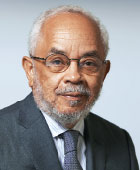Memorializing Dignity and Identity in Public Monuments

In late November, just before the Thanksgiving holiday, a friend wrote from Barbados to deliver the long-awaited news. After decades of debate, the island’s government had removed the statue of Vice Adm. Lord Horatio Nelson (1758-1805) to a nearby museum. For over 200 years, it had occupied a central place in the island’s Trafalgar Square, opposite the Parliament buildings. Nelson has been hailed as a highly decorated British naval commander, a model of military heroism and tenacity. In recent years, there have been discussions about whether he helped maintain slavery in the British Caribbean islands. Other commentators argue that as a naval officer, it was simply his duty to protect the political economy of Britain, a colonial and slave-holding power at the time.
I still remember from the 1950s a policeman standing on a small circular platform next to the statue directing traffic. He did so with a military precision that made all of us youngsters dream of being so publicly ambidextrous and performative. I recall the arms that moved decisively to control the movement of cars and pedestrians. This was in an area that most of the islanders would pass at least once a week. Nelson was a striking symbol: inscrutable, daring visitors to guess at why he surveyed all before him with such majesty and confidence. Technological advances eventually brought stoplights to the spot, causing the policeman to be superfluous. Nelson stayed on, defying hurricanes and all else, even the island’s 1966 independence.
A colleague noted that there is now a recognized defining connection among history, its iconography, and identity. People pose questions pugnaciously about statues, recognizing that they are interrogating themselves and their dignity. In November 2016, Professor Richard Drayton from Kings College London delivered the Sir Winston Scott Memorial Lecture that marked the 50th anniversary of Barbados’s independence. He challenged the island’s citizens to think about what they were doing with their sovereignty and independence. Drayton acknowledged the island’s long history of colonization by Britain that had instilled crippling self-doubt in Barbadians after protracted colonial dependency. He also referred to the international architecture of white supremacy that Europeans had so studiously put together. In the years following independence, Barbadians took note of developments in the arenas of civil rights, human rights, and protest politics. Eventually, their eyes focused on this statue of Lord Nelson placed so provocatively in their midst next door to their Parliament.
Their questions had to come. They did come. After all, Barbadians read and travel and take stock of what is happening overseas. Museums and different forms of media comment on statues and paintings located in the public sphere. These institutions have been educating us about how these artistic renderings regularly embody special values held dear by their national leadership. We know now that the artistic devices often signify that white supremacy supersedes Black lives in significance. The statue regularly bears witness, borrowing Drayton’s expression, to a regimen of economic, social, political, cultural, and spiritual dispossession.
This removing of statues is, of course, not a uniquely Barbadian or Caribbean phenomenon. American universities and governmental agencies have struggled with it for years. The debates have left in their wake some important questions: What moral lessons do the statues convey to the public? Whose heroism do they represent? Who is threatened by them and why? Finally, in the case of Nelson’s statue, how did Black parents ever explain its presence to their children?
Today’s Barbadians claim that it is time to celebrate native heroes; to build a record of Barbadian achievement; to dignify the humanity in Barbadians, not the inhumanity of colonial oppression and slavery. As the Caribbean poet Derek Walcott put it in The Prodigal (Farrar, Straus and Giroux, 2004), it is time to memorialize the unimportant beauty of the Caribbean village; to rid ourselves of the envy of European statues; and for Barbadians to feel “that humming that goes on in the tired heart once you are home.” ■



